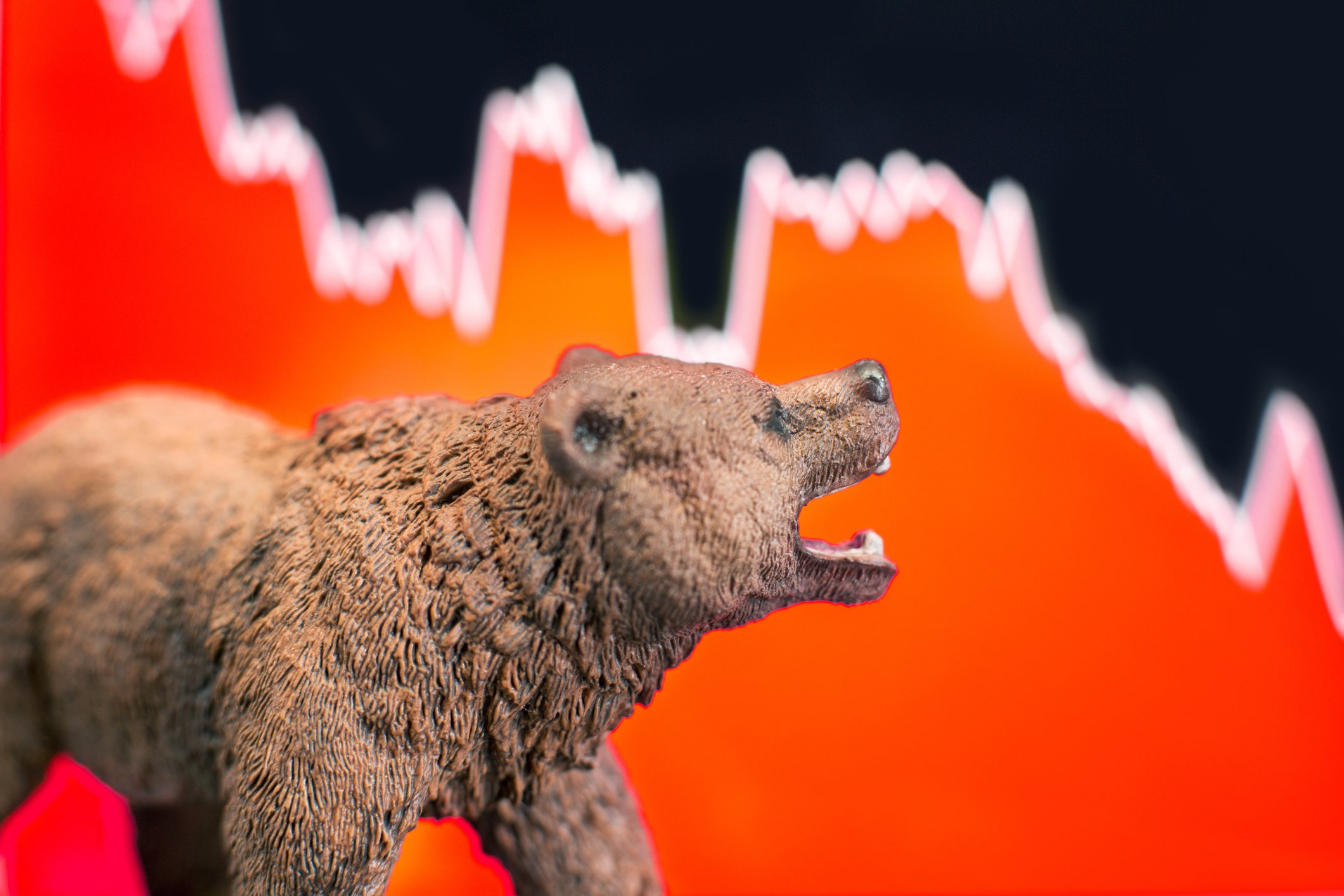If you're a long-term investor, the past 10 years have been a thing of beauty. After bottoming out during the great recession, the broad-based S&P 500 (^GSPC 0.06%), iconic Dow Jones Industrial Average (^DJI 0.17%), and tech-heavy Nasdaq Composite (^IXIC 0.06%) have effectively quadrupled to quintupled in value.
But for many investors, the harshest recession since the Great Depression is also still fresh in their minds. Contractions and recessions are a natural part of the economic cycle, making it a matter of when, not if, the next one will strike.

Image source: Getty Images.
Recession fears are growing
In recent months, we've witnessed a number of red flags that are suggestive of looming trouble. The one investors are probably most familiar with is the inversion of the Treasury bond yield curve.
Generally, we'd expect to see bonds with longer maturities bear higher yields, which makes sense given that investors are parting with their money for a longer period of time and want to be compensated for that fact. Recently, though, we witnessed this upward sloping yield curve flatten out, and eventually invert, whereby shorter-term bonds had higher yields than longer-term bonds (more specifically, the 10-year Treasury bond had a lower yield than the two-year bond, which is the true basis of an "inverted yield curve"). Although an inverted yield curve does not always lead to a recession, every recession since World War II has been preceded by a yield-curve inversion.
Another sore spot has been U.S. manufacturing. Even though the U.S. has become more dependent on sectors like technology to drive growth, manufacturing still represents a core component to U.S. economic expansion. In October, the ISM Purchasing Managers' Index came in at 48.3%. Any figure below 50% represents manufacturing sector contraction. This marked the third-straight month of contraction, and followed a September 2019 reading that was the lowest in more than 10 years.
We've also witnessed a significant increase in corporate debt this decade, compared to traditional loans from financial institutions. This U.S. nonfinancial corporate debt stood at almost $10 trillion by midyear, equating to 48% of U.S. GDP. This is 52% higher than the $6.6 trillion in corporate debt companies held on their balance sheets during the third quarter of 2008, the height of the Great Recession.

Image source: Getty Images.
Always the savior, the Fed may have its hands tied during the next recession
In pretty much each and every post-World-War-II recession, investors have turned to our nation's central bank to wave its wand and make everything better in relatively short order.
The Federal Reserve does this by influencing short-term interest rates, or more specifically the federal funds target rate. This is the rate that financial institutions (banks and credit unions) lend to each other overnight on an uncollateralized basis. Though the Fed doesn't directly influence benchmark interest rates, its federal funds target rate changes do trickle down and impact everything from credit card interest rates to bank loans and even mortgages, to some degree. Thus, if it wants to stimulate U.S. economic growth and/or boost inflation, it'll take a dovish approach by lowering the federal funds target rate to entice lending. Conversely, it'll become hawkish and boost the federal funds target rate if it wants to keep the economy, or inflation, from overheating.
Sounds pretty straightforward, right?
But here's the problem: After seven years of a historically low federal funds rate (0% to 0.25%), the Fed was only able to manage nine quarter-point (i.e., 25 basis point) rate hikes to a range of 2.25% to 2.5% before its most recent shift to dovish monetary policy in mid-2019. Following last week's rate cut, the federal funds rate now sits at 1.5% to 1.75%.
Historically, the Fed has had to reduce its federal funds rate by 500 basis points to stimulate the U.S. economy out of recession. But beginning with a maximum base of 2.5% at the end of 2018, the Fed has only half of its historical average to work with before hitting 0%.

Image source: Getty Images.
Unconventional monetary policy may not work when the next recession strikes
According to a Federal Reserve Bank of San Francisco (FRBSF) Economic Letter penned by Senior Policy Advisor and Executive VP of the FRBSF, Glenn Rudebusch, historically low lending rates will likely coerce the Fed to use unconventional tactics when fighting the next recession.
One method, which we saw during and after the Great Recession, is the use of quantitative easing (QE). This involves the central bank purchasing Treasury notes to drive down yields in order to boost lending activity. QE also involved the Fed purchasing mortgage-backed securities at a time when the housing market was the shakiest it had ever been.
A second unconventional tool at its disposal, according to Rudebusch, is forward guidance. In layman's terms, the Fed used its own guidance on short-term rates to push down yields on long-term bonds, thereby easing financial conditions and spurring lending. The Fed can't impact the perceived premium of holding long-term bonds, but it can certainly offer toned-down guidance about short-term rates, which can effectively impact the collective view of long-term yields.
However, the impact of unconventional monetary policy tools isn't as clear. Though the Fed is credited with saving the day following the Great Recession, it also had more than 500 basis points of federal funds rate cuts to work with. Central banks that haven't had this sort of runway to cut rates, such as Japan and the European Central Bank, have not had very good success with unconventional easing tools. In fact, growth in these regions has stagnated for some time now.
In other words, the Fed may not be able to come to the rescue of the stock market during the next recession.

Image source: Getty Images.
Run and hide? Not exactly.
So, what's an investor to do? Take their money and run? Hide it under the mattress and hope for the best? The correct answer is almost certainly neither.
If long-term investors simply stick to their game plan and stay the course, history shows they'll be handsomely rewarded. Even if the Fed isn't able to save the S&P 500, Dow Jones Industrial Average, and Nasdaq Composite from a bear market decline, history finds that these declines are buying opportunities, not reasons to panic.
Since 1950, there have been 37 official stock market corrections in the S&P 500. By "official," I mean a decline of at least 10% from a recent high, not including rounding. But here's the really telling fact: Each and every one of these 37 corrections has eventually been erased by a bull market rally. In fact, it often takes mere months for the market to recoup most, or all, of its losses. Therefore, staying invested is going to be the smart move to make, even if recession warning signs are cropping up.
But if you want to be proactive, nevertheless, it might be a good time to consider adding time-tested dividend stocks, as well as value stocks, to your portfolio.
Dividend stocks already provide a host of advantages to investors. They're often profitable, have times-tested business models, and you can reinvest these payouts via a dividend reinvestment plan to quickly compound your wealth. But as an added bonus, dividend stocks may also offer superior income in this potentially long-term low-yield environment.

Image source: Getty Images.
Take AT&T (T 1.01%) as an example. It's a generally boring wireless and content company with a low- to mid-single-digit growth rate. But AT&T possesses one of the safest 5.3% annual yields on the planet, and it happens to be far less volatile than the general market. Since AT&T's high-margin wireless service is subscription based, it makes it unlikely that a downturn in the economy will cause a significant impact to its bottom line. AT&T provides time-tested predictability, and that could come in handy during the next recession.
Also, whereas growth stocks have been the prime beneficiary of the Fed's long-term easing, it's value stocks that could reemerge as the superior play during a recession. We often see income statements analyzed with a fine-toothed comb during economic contractions, which is why a company like CVS Health (CVS 3.39%) might be worth a look.
CVS Health is the nation's leading pharmacy chain operator. Though lower-margin front-end sales could be impacted by a recession, healthcare, in general, is shielded by the fact that we don't get to choose when we get sick or wait ailment(s) we develop. This ensures continued demand for CVS Health's higher-margin pharmaceutical business. At a mere 9 times next year's earnings per share forecast, per Wall Street, CVS Health could be the type of stock that helps investors thrive during a recession.










